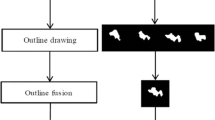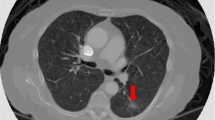Abstract
Purpose
Lung cancer is the leading cause of cancer-related deaths in the world. Its diagnosis is a challenge task to specialists due to several aspects on the classification of lung nodules. Therefore, it is important to integrate content-based image retrieval methods on the lung nodule classification process, since they are capable of retrieving similar cases from databases that were previously diagnosed. However, this mechanism depends on extracting relevant image features in order to obtain high efficiency. The goal of this paper is to perform the selection of 3D image features of margin sharpness and texture that can be relevant on the retrieval of similar cancerous and benign lung nodules.
Methods
A total of 48 3D image attributes were extracted from the nodule volume. Border sharpness features were extracted from perpendicular lines drawn over the lesion boundary. Second-order texture features were extracted from a cooccurrence matrix. Relevant features were selected by a correlation-based method and a statistical significance analysis. Retrieval performance was assessed according to the nodule’s potential malignancy on the 10 most similar cases and by the parameters of precision and recall.
Results
Statistical significant features reduced retrieval performance. Correlation-based method selected 2 margin sharpness attributes and 6 texture attributes and obtained higher precision compared to all 48 extracted features on similar nodule retrieval.
Conclusion
Feature space dimensionality reduction of 83 % obtained higher retrieval performance and presented to be a computationaly low cost method of retrieving similar nodules for the diagnosis of lung cancer.



Similar content being viewed by others
References
Howlader N, Noone A, Krapcho M, Garshell J, Miller D, Altekruse S, Kosary C, Yu M, Ruhl J, Tatalovich Z, Mariotto A, Lewis D, Chen H, Feuer E, Cronin K (2015) SEER cancer statistics review (1975–2012). National Cancer Institute. http://seer.cancer.gov/csr/1975_2012/. Accessed 12 Feb 2016
Truong MT, Ko JP, Rossi SE, Rossi I, Viswanathan C, Bruzzi JF, Marom EM, Erasmus JJ (2014) Update in the evaluation of the solitary pulmonary nodule. RadioGraphics 34(6):1658–1679
Bartholmai BJ, Koo CW, Johnson GB, White DB, Raghunath SM, Rajagopalan S, Moynagh MR, Lindell RM, Hartman TE (2015) Pulmonary nodule characterization, including computer analysis and quantitative features. J Thorac Imaging 30(2):139–156
Doi K (2007) Computer-aided diagnosis in medical imaging: historical review, current status and future potential. Comput Med Imaging Graph 31(4–5):198–211
Bedo MVN, Santos DP, Ponciano-Silva M, Azevedo-Marques PM, Carvalho APLF, Traina C Jr (2016) Endowing a content-based medical image retrieval system with perceptual similarity using ensemble strategy. J Digit Imaging 29(1):22–37
Akgül CB, Rubin DL, Napel S, Beaulieu CF, Greenspan H, Acar B (2011) Content-based image retrieval in radiology: current status and future directions. J Digit Imaging 24(2):208–222
Xu J, Napel S, Greenspan H, Beaulieu CF, Agrawal N, Rubin D (2012) Quantifying the margin sharpness of lesions on radiological images for content-based image retrieval. Med Phys 39:5405–5418
Oliveira MC, Ferreira JR (2013) A bag-of-tasks approach to speed up the lung nodules retrieval in the bigdata age. In: Proceedings of the 15th IEEE international conference on e-health networking, application and services (IEEE HealthCom), pp 632–636
Lam MO, Disney T, Raicu DS, Furst J, Channin DS (2007) BRISC—an open source pulmonary nodule image retrieval framework. J Digit Imaging 20(1):63–71
Lam M, Disney T, Pham M, Raicu D, Furst J, Susomboon R (2007) Content-based image retrieval for pulmonary computed tomography nodule images. Med Imaging 6516:65160N
Aggarwal P, Sardana H, Vig R (2014) Content based image retrieval approach in creating an effective feature index for lung nodule detection with the inclusion of expert knowledge and proven pathology. Curr Med Imaging Rev 10(3):178–204
Aggarwal P, Vig R, Sardana H (2016) Lung cancer detection using fusion of medical knowledge and content based image retrieval for lidc dataset. J Med Imaging Health Inform 6(2):297–311
Levman JE, Martel AL (2011) A margin sharpness measurement for the diagnosis of breast cancer from magnetic resonance imaging examinations. Acad Radiol 18(12):1577–1581
Cataldo S, Bottino A, Islam I, Vieira T, Ficarra E (2014) Subclass discriminant analysis of morphological and textural features for HEp-2 staining pattern classification. Pattern Recognit 47(7):2389–2399
Armato SG III, McLennan G, Bidaut L, McNitt-Gray MF, Meyer CR, Reeves AP, Zhao B, Aberle DR, Henschke CI, Hoffman EA (2011) The lung image database consortium (LIDC) and image database resource initiative (IDRI): a completed reference database of lung nodules on CT scans. Med Phys 38:915–931
Junior JRF, Oliveira MC, Azevedo-Marques PM (2016) Cloud-based NoSQL open database of pulmonary nodules for computer-aided lung cancer diagnosis and reproducible research. J Digit Imaging:1–14. doi:10.1007/s10278-016-9894-9
Junior JRF, Oliveira MC, Azevedo-Marques PM (2016) Integrating 3D image descriptors of margin sharpness and texture on a GPU-optimized similar pulmonary nodule retrieval engine. J Supercomput: 1–17. doi:10.1007/s11227-016-1818-4
Haralick RM, Shanmugam K, Dinstein IH (1973) Textural features for image classification. IEEE Trans Syst Man Cybern 6:610–621
Witten IH, Frank E (2011) Data mining: practical machine learning tools and techniques. Morgan Kaufmann, Burlington
Müller H, Müller W, Squire DM, Marchand-Maillet S, Pun T (2001) Performance evaluation in content-based image retrieval: overview and proposals. Pattern Recognit Lett 22(5):593–601
Tamura H, Mori S, Yamawaki T (1978) Textural features corresponding to visual perception. IEEE Trans Syst Man Cybern 8(6):460–473
Borowska M, Szarmach J, Oczeretko E (2015) Fractal texture analysis of the healing process after bone loss. Comput Med Imaging Graph 46:191–196
Mallat SG (1989) A theory for multiresolution signal decomposition: the wavelet representation. IEEE Trans Pattern Anal Mach Intell 11(7):674–693
Fedorov A, Beichel R, Kalpathy-Cramer J, Finet J, Fillion-Robin J-C, Pujol S, Bauer C, Jennings D, Fennessy F, Sonka M, Buatti J, Aylward S, Miller J, Pieper S, Kikinis R (2012) 3D Slicer as an image computing platform for the Quantitative Imaging Network. Magn Reson Imaging 30(9):1323–1341
Velazquez ER, Parmar C, Jermoumi M, Mak RH, van Baardwijk A, Fennessy FM, Lewis JH, De Ruysscher D, Kikinis R, Lambin P, Aerts H (2013) Volumetric CT-based segmentation of NSCLC using 3D-Slicer. Sci Rep 3:3529
Bugatti PH, Kaster DS, Ponciano-Silva M, Traina C, Azevedo-Marques PM, Traina AJ (2014) PRoSPer: perceptual similarity queries in medical CBIR systems through user profiles. Comput Biol Med 45:8–19
Acknowledgments
This study was funded by Fundação de Amparo à Pesquisa do Estado de Alagoas (Grant Number 20130603-002-0040-0063) with a master scholarship to José Raniery Ferreira Junior.
Author information
Authors and Affiliations
Corresponding author
Ethics declarations
Conflict of interest
The authors declare that they have no conflict of interest.
Ethical approval
For this type of study, formal consent is not required. This study used a public image database, which all protected health information (PHI) contained within the DICOM headers of the images were removed in accordance with Health Insurance Portability and Accountability Act (HIPAA) guidelines.
Rights and permissions
About this article
Cite this article
Ferreira, J.R., de Azevedo-Marques, P.M. & Oliveira, M.C. Selecting relevant 3D image features of margin sharpness and texture for lung nodule retrieval. Int J CARS 12, 509–517 (2017). https://doi.org/10.1007/s11548-016-1471-7
Received:
Accepted:
Published:
Issue Date:
DOI: https://doi.org/10.1007/s11548-016-1471-7




